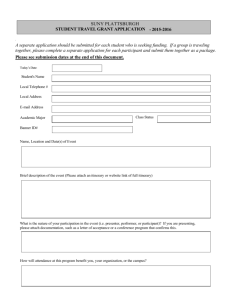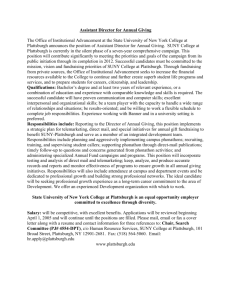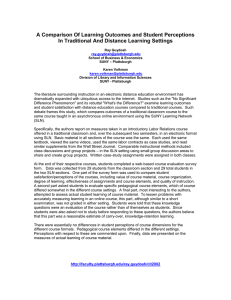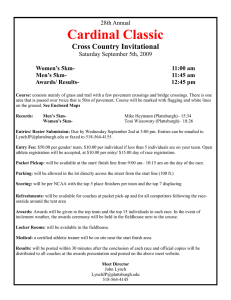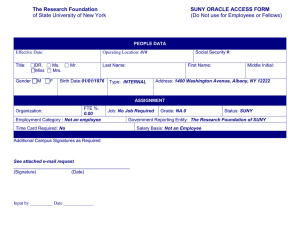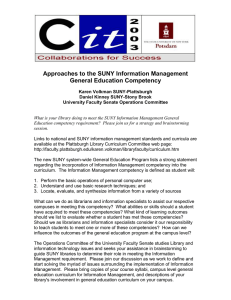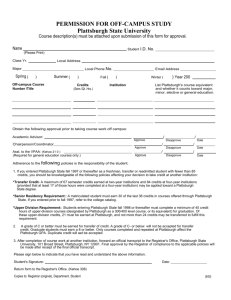General Education Plan PSU
advertisement
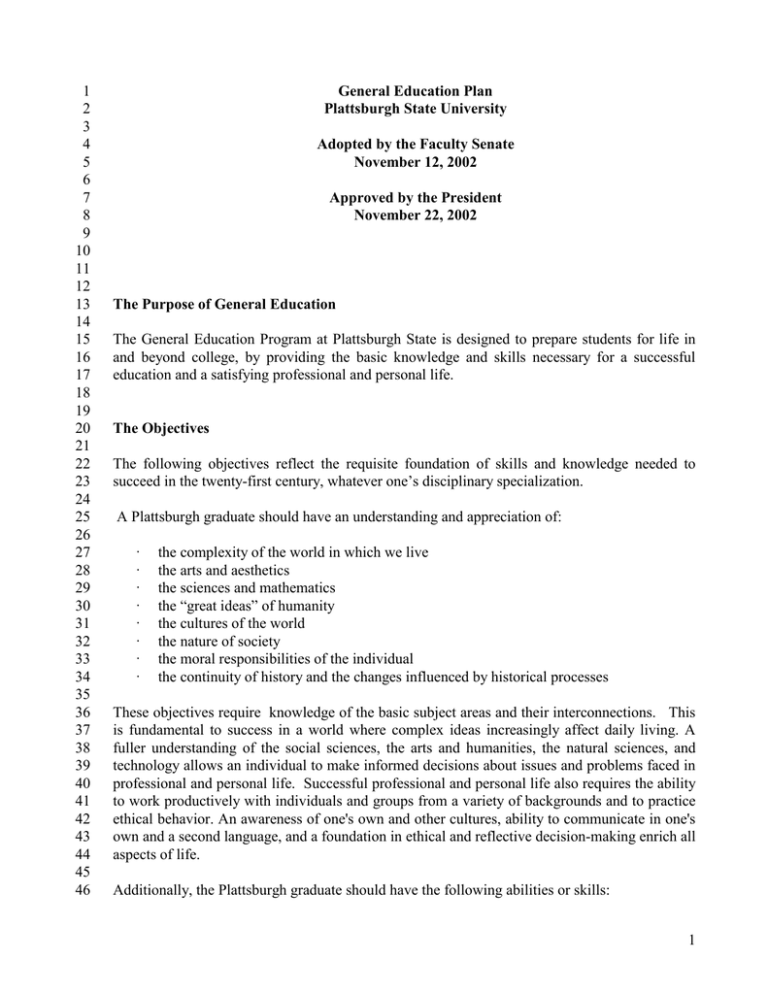
1 2 3 4 5 6 7 8 9 10 11 12 13 14 15 16 17 18 19 20 21 22 23 24 25 26 27 28 29 30 31 32 33 34 35 36 37 38 39 40 41 42 43 44 45 46 General Education Plan Plattsburgh State University Adopted by the Faculty Senate November 12, 2002 Approved by the President November 22, 2002 The Purpose of General Education The General Education Program at Plattsburgh State is designed to prepare students for life in and beyond college, by providing the basic knowledge and skills necessary for a successful education and a satisfying professional and personal life. The Objectives The following objectives reflect the requisite foundation of skills and knowledge needed to succeed in the twenty-first century, whatever one’s disciplinary specialization. A Plattsburgh graduate should have an understanding and appreciation of: · · · · · · · · the complexity of the world in which we live the arts and aesthetics the sciences and mathematics the “great ideas” of humanity the cultures of the world the nature of society the moral responsibilities of the individual the continuity of history and the changes influenced by historical processes These objectives require knowledge of the basic subject areas and their interconnections. This is fundamental to success in a world where complex ideas increasingly affect daily living. A fuller understanding of the social sciences, the arts and humanities, the natural sciences, and technology allows an individual to make informed decisions about issues and problems faced in professional and personal life. Successful professional and personal life also requires the ability to work productively with individuals and groups from a variety of backgrounds and to practice ethical behavior. An awareness of one's own and other cultures, ability to communicate in one's own and a second language, and a foundation in ethical and reflective decision-making enrich all aspects of life. Additionally, the Plattsburgh graduate should have the following abilities or skills: 1 47 48 49 50 51 52 53 54 55 56 57 58 59 60 61 62 63 64 65 66 67 68 69 70 71 72 73 74 75 76 77 78 79 80 81 82 83 84 85 86 87 88 89 90 · · · · · · ability to read with comprehension ability to apply quantitative skills ability to communicate effectively in written and spoken English ability to communicate in a second language ability to use technology effectively ability to filter, analyze and critique information and experience Writing, speaking and critical thinking are necessary for the formulation and communication of knowledge and reasoned opinions. Finding useful and reliable information to enhance knowledge and upon which to base opinions is critical in a time of rapidly growing access to information, as is the ability to manage that information with a variety of technologies. Understanding basic mathematical operations is preparation for both financial management and critical analysis of statistical data that justifies social, political and personal decisions. Assumptions The program outline below is based on several assumptions: 1. that students will enter PSU with competencies · in foreign language equal to FL 111, · in English composition equal to ENG 100, and · in mathematics equal to MAT 101. Students who do not have these competencies when they enter PSU will achieve them before completing the related parts of their general education program. 2. that a writing-across-the-curriculum requirement at PSU will continue to exist; 3. that any semester-long, approved, and satisfactorily completed study abroad course of study will satisfy the 6-credit Integration component; 4. that an assessment program will be developed, and will include required participation of upper division students as part of the Global Issues course; 5. that a significant faculty development program will be initiated and maintained to reinforce this general education program; 6. that a Learning Communities Coordinator will be appointed (preferably a senior faculty member with a half-time obligation) to help set up and foster learning communities through faculty development workshops; 7. that the standing committee on general education will continue to provide oversight; and 2 91 92 93 94 95 96 97 98 99 100 101 102 103 104 105 106 107 108 109 110 111 112 113 114 115 116 117 118 119 120 121 122 123 124 125 126 127 128 129 130 131 132 133 134 135 136 8. that the college will continue to support experiential education opportunities including service learning. Requirements Any credits released from our current general education requirements (41-46 credit hours) by the adoption of a new program must become electives, to be used at the student’s discretion. Learning Communities The General Education Program encourages Learning Communities that further the specific goals of general education and enhance the teaching and learning environment. In Learning Communities, instructors work together to improve pedagogy; students work together to learn. Students are afforded the opportunity to develop skills and study subject matter in an interdisciplinary environment and to satisfy general education requirements and achieve learning outcomes without necessarily taking individual courses designed to accomplish these ends. The keys to Learning Community success are faculty collaboration, small class size, unity of focus, and increased opportunities for student-faculty interaction. It is a goal of the General Education Program that a substantial number of students will have access to such learning opportunities. To this end, the General Education Committee will entertain proposals for specially designed thematic Learning Communities that embed learning skills or subject matter across the curriculum, thereby allowing students to satisfy General Education requirements or learning outcomes objectives in a coordinated academic environment. In some cases students in Learning Communities will be able to demonstrate proficiency in SUNY Required Learning Outcomes and/or PSU General Education Requirements based on the synergistic effect of all the courses in the Learning Community. Transcripts of such students will show a proficiency designation but no credit for the category satisfied. Portfolios or other alternate means of demonstrating proficiency in a general education outcome or requirement might also be produced in conjunction with credit bearing integrative seminars or tutorials. Design of Learning Communities: 1. Each Learning Community will consist of at least three courses or nine credit hours taken simultaneously by the same group of students. 2. Enrollments cannot exceed 25 students per section. 3. Learning Communities may include beyond the basic three courses or nine hours a larger core course taken in common or an integrative seminar or reflective tutorial of from one to four credits. If a large class is added, its syllabus must be integrated with the Learning Community; simply attaching a large class without coordination is not acceptable. 4. All Learning Communities are expected to satisfy the SUNY Required Learning Outcomes for oral communication. 5. Learning Communities may include a service learning component. 3 137 138 139 140 141 142 143 144 145 146 147 148 149 150 151 152 153 154 155 156 157 158 159 160 161 162 163 164 165 166 167 168 169 170 171 172 173 174 175 176 177 178 179 180 181 182 Special courses: The General Education Committee will consider for approval for General Education credit courses that will only be offered as part of Learning Communities. Therefore, the General Education Program can contain courses that will not be offered except as part of Learning Communities. These will include courses, seminars or tutorials that help students integrate Learning Community material as well as other special offerings that depend on the cumulative effect of a particular cluster of courses. Approval: Learning Communities that offer alternative routes to satisyfying general education requirements need to be approved by the General Education Committee. Proposals for such communities must be submitted to the General Education Committee according to a schedule that will be published annually. The Committee will furnish applicants with guidelines for submission. The Committee will establish a Subcommittee on Learning Communities in order to expedite responses to submissions. The Program The General Education Program will strengthen students’ skills and abilities and expand their appreciation and understanding in all the areas listed in the objectives above. In completing the program, students will also meet all the SUNY System requirements for general education. The General Education Program (39 credits) includes the following elements: The Skills 1. Mathematics -- Courses in this category introduce students to mathematical thinking and logic, building upon the basic skills required by SUNY: “arithmetic, algebra, geometry, data analysis, and quantitative reasoning” (SUNY Required Learning Outcomes). Courses will emphasize the applicability of mathematics to “real life” and will be designed to instill in all students a sense of mathematics as a creative and useful endeavor. Courses focus on developing in the student an understanding and appreciation of mathematics and the great ideas of humanity and reinforce the students’ ability to apply quantitative skills, and to filter, analyze and critique information and experiences (Plattsburgh General Education Objectives). 3 credits 2. Oral Expression -- Specially designated oral expression courses assist students to “develop [college-level] proficiency in oral discourse; . . . evaluate an oral presentation according to established criteria” (SUNY Required Learning Outcomes); and communicate effectively in spoken English (Plattsburgh General Education Objectives). (Students must take among their courses at least two that are designated as oral expression courses.) 0 credits 3. Information and Technology Literacy -- Courses in this category will ensure that students have mastered the skills and concepts basic to information and technology literacy. Students will demonstrate the ability to “perform the basic operations of personal computer use; understand and use basic research techniques; and locate, evaluate and synthesize 4 183 184 185 186 187 188 189 190 191 192 193 194 195 196 197 198 199 200 201 202 203 204 205 206 207 208 209 210 211 212 213 214 215 216 217 218 219 220 221 222 223 224 225 226 227 information from a variety of sources” (SUNY Required Learning Outcomes). Courses in this category will focus on the ability to use technology effectively and the ability to filter, analyze, and critique information and experience (Plattsburgh General Education Objectives). 1 credit 4. Written Expression -- Courses in this category develop in students the ability to “produce coherent texts within common college level written forms; . . . revise and improve such texts; . . . develop an argument [, based on evidence], and organize supporting details” (SUNY Required Learning Outcomes); and communicate effectively in written English (Plattsburgh General Education Objectives). Courses provide extensive practice in writing and revision in order to help students develop the ability to write clear, effective English prose. 3 credits The Knowledge and Understanding 5. Natural Sciences and Technology -- Courses in this category develop in students “understanding of the methods scientists use to explore natural phenomena” and “application of scientific data, concepts, and models in one of the natural sciences” (SUNY Required Learning Outcomes). Courses will explore the fundamental assumptions and principles of the scientific method, illustrated by laboratory and/or field work. Courses will make clear the difference between science and technology and enable students to critically assess technological worth. Courses will strengthen students’ skills in qualitative and quantitative reasoning and in critical thinking and analysis, by careful study of both historic and contemporary scientific problems. In addition, courses will reinforce students’ understanding and appreciation of the sciences and their ability to use technology effectively (Plattsburgh General Education Objectives). (Each student must complete one 3- or 4-credit SUNY approved course; the remaining 1 or 2 credits can be completed with a second 3- or 4-credit course or one or more 1- or 2-credit topics courses.) 5 credits 6. Social Sciences -- Courses in this category provide students with “understanding of the methods social scientists use to explore social phenomena” and “knowledge of the major concepts of one or more disciplines in the social sciences” (SUNY Required Learning Outcomes). Courses focus on developing in students an understanding and appreciation of the complexity of our world, the great ideas and cultures of the world, the nature of society, and the moral responsibility of the individual (Plattsburgh General Education Objectives). Courses reinforce the students’ ability to read with comprehension, to communicate effectively in written and spoken English, to use technology effectively, (while also assessing the impact of technological innovation), and to filter, analyze and critique information and experiences (Plattsburgh General Education Objectives). 3 credits 7. Civilizations of the World 5 228 229 230 231 232 233 234 235 236 237 238 239 240 241 242 243 244 245 246 247 248 249 250 251 252 253 254 255 256 257 258 259 260 261 262 263 264 265 266 267 268 269 270 271 272 273 a. U.S. -- Courses in this category expand students’ “understanding of common institutions in American society and how they have affected different groups” and their “understanding of America’s evolving relationship with the rest of the world.” Students must also demonstrate “knowledge of a basic narrative of American history” (SUNY Required Learning Outcomes). Courses will include aboriginal concerns, immigration, inequality, growth, colonialism, the environment, and issues of power and conflict, especially in a North American context. Courses focus on developing in students an understanding and appreciation of the complexity of our world, the nature of society, the moral responsibility of the individual, and the continuity of history and the changes influenced by historical processes (Plattsburgh General Education Objectives). Courses reinforce the students’ ability to read with comprehension, to communicate effectively in written and spoken English, and to filter, analyze and critique information and experiences (Plattsburgh General Education Objectives). 3 credits b. Western -- Courses in this category impart “knowledge of the development of the distinctive features of the history, institutions, economy, society, culture, etc. of Western civilization” and “relate the development of Western civilization to that of other regions of the world” (SUNY Required Learning Outcomes). Courses will include attention to such matters as emigration and immigration, art, music, philosophy, literature, religion and conflict. Courses focus on developing in students an understanding and appreciation of the complexity of our world, the great ideas and cultures of the world, the nature of society, the moral responsibility of the individual, and the continuity of history and the changes influenced by historical processes (Plattsburgh General Education Objectives). Courses reinforce the students’ ability to read with comprehension, to communicate effectively in written and spoken English, and to filter, analyze and critique information and experiences (Plattsburgh General Education Objectives). 3 credits c. World Systems -- Courses in this category impart “knowledge of either a broad outline of world history, or the distinctive features of the history, institutions, economy, society, culture, etc. of one non-Western civilization” (SUNY Required Learning Outcomes). Courses focus on developing in students an understanding and appreciation of the complexity of our world, the great ideas and cultures of the world, the nature of society, the moral responsibility of the individual, and the continuity of history and the changes influenced by historical processes (Plattsburgh General Education Objectives). Courses reinforce the students’ ability to read with comprehension, to communicate effectively in written and spoken English, and to filter, analyze and critique information and experiences (Plattsburgh General Education Objectives). 3 credits 8. Humanities -- Courses in this category provide students with “knowledge of the conventions and methods of at least one of the humanities” (SUNY Required Learning Outcomes). Courses focus on developing in students an understanding and appreciation of the complexity of our world, aesthetics, the great ideas and cultures of the world, and the moral responsibilities of the individual (Plattsburgh General Education Objectives). Courses reinforce students’ ability to read with comprehension, to communicate effectively in written and spoken English, and to filter, analyze, and critique information and experiences (Plattsburgh General Education Objectives). 3 credits 6 274 275 276 277 278 279 280 281 282 283 284 285 286 287 288 289 290 291 292 293 294 295 296 297 298 299 300 301 302 303 304 305 306 307 308 309 310 311 312 313 314 315 316 317 318 9. The Arts -- Courses in this category provide students with “understanding of at least one principal art form and the creative processes inherent therein” (SUNY Required Learning Outcomes). Courses focus on developing in students an understanding and appreciation of the complexity of our world, the arts and aesthetics, the great ideas and cultures of the world, and the moral responsibilities of the individual (Plattsburgh General Education Objectives). Courses reinforce students’ ability to communicate effectively and to filter, analyze and critique information and experience (Plattsburgh General Education Objectives). 3 credits 10. Foreign Language -- Courses in this category will be at the FL 112 level initially, with the level to be raised as the level required for high school graduation in New York State rises. These courses will build upon the basic skills required by SUNY (basic proficiency in the understanding and use of a foreign language and knowledge of the distinctive features of cultures associated with the language, at the FL 111 level). Courses focus on developing in students an understanding and appreciation of the complexity of our world and understanding and appreciation of the cultures of the world (Plattsburgh General Education Objectives). Courses reinforce the students’ ability to communicate in a second language (Plattsburgh General Education Objectives). 3 credits The Integration 11.Global Issues -- Courses in this area encourage students to think transnationally or transculturally about social, political, economic, aesthetic, moral, and technological issues. These courses will contribute to students’ understanding about issues such as human rights, migration, trade, poverty, access to health care, and technology, and the ramifications of policies regarding political power, militarization, and the environment. A course offered in this area will engage in comparative studies of a global theme across different nations, cultural groups, or cultural regions. Courses in this area will be upper division and will build on and integrate the knowledge and skills acquired in the first two sections of the program. 3 credits 12. One of the following (a or b): a. Individual, Society and Responsibility -- Courses in this area investigate the conflicts and tensions between individuals and societies that motivate questions of responsibility. Students will develop and apply skills in ethical reasoning and come to understand the ways ethical issues affect individual behavior, lifestyles, and public life. Courses will focus on issues regarding institutions of health, education, economics, or leisure and entertainment; patterns of human development; social constructions of gender, sexuality, race, ethnicity, nationality, class, and the like; conflicts between public and private life; or, institutionalized beliefs, values, and world views. Courses in this area will be upper division and will build on and integrate the knowledge and skills acquired in the first two sections of the program. A course offered in this area will meet at least one of the following conditions: 7 319 320 321 322 323 324 325 326 327 328 329 330 331 332 333 334 335 336 337 338 339 340 341 342 343 344 345 346 347 348 349 350 351 352 353 354 355 356 357 358 359 360 361 362 1. It explores the relationship between the individual and society from one or more cultural, religious, or philosophical perspectives. 2. It examines social, political, or ethical issues and controversies within a particular historical, disciplinary, professional, or policy context. 3. It combines coursework (rigorous reflection and writing) and extra-mural community service. 3 credits b. Art, Literature, and Interpretation -- Courses in this area will enhance students’ appreciation for the fine arts, literatures, and narratives by which we articulate the human condition. Students will learn to interpret vartious kinds of artistic experession in terms of their styles, genres, histories, or aesthetic qualitits. These courses use discipline specific as well as interdisciplinary methodologies to study meanings and effects of artistic expression, and develop critical and theoretical perspectives for engaging art and literature. Courses in this area will be upper division and will build on and integrate the knowledge and skills acquired in the first two sections of the program. A course offered in this area will meet at least one of the following conditions: 1. It emphasizes explicit instruction in critical methods in the humanities and arts. 2. It teaches students how to develop interpretative arguments. 3. It promotes contextually groaunded focuses on teaching critical interpretation of fine arts and/or literature. 3 credits Policies and Procedures for Implementing the General Education Program A. Common Goals Expressed in Common Formats 1. To be approved for general education credit in the skills and knowledge and understading components, a course must be specifically designed for a general education audience; courses in the upper-division integration component must demonstrate appropriateness for a general education audience. 2. General education courses will: a. reinforce oral and written communication skills; b. integrate critical thinking and information literacy/management competencies into the curriculum; c. reflect diversity of content and scholarship and offer a broad focus; d. engage students in critical reflection on issues of race, gender, and class appropriate to content; e. include regional or local content where appropriate; f. include international content where appropriate; g. include technology appropriate to the discipline; and h. include an ethics component. 8 363 364 365 366 367 368 369 370 371 372 373 374 375 376 377 378 379 380 381 382 383 384 385 386 387 388 389 390 391 392 393 394 395 396 397 398 399 400 401 402 403 404 405 406 407 3. To be approved, General Education courses must show how they meet the overall goals of General Education, and how they address the objectives of the particular category they serve. 4. Course proposals for the General Education curriculum must follow the common format devised by the General Education Committee. B. Quality and Pedagogy In order to assure engagement of students in learning and high standards of quality, courses approved for the General Education Program must demonstrate principles of good practice in undergraduate education, such as: 1. Communicating High Expectations and Course Standards: Course proposals must describe how high expectations and standards shall be communicated to students: a) Course descriptions must indicate what level of skills and knowledge are required for the course. b) Course descriptions must indicate how course materials and texts meet the objectives of the category. c) Efforts must be made to acquaint students with issues and materials relating to the topics addressed. d) Course requirements should ensure that students spend adequate time on assignments which should be evaluated frequently and promptly. e) Types and frequency of assignments should be listed in the courses proposed for General Education. 2. Fostering Active Learning: To be approved, course proposals for General Education are expected to show how students can be actively engaged in learning. Students should be encouraged to talk and write about what they are learning and apply it. Some examples of active learning approaches include class discussions, study groups, structured exercises, peer critiques, in-class writing and team projects. 3. Reinforcing and Integrating Skills and Content: Course proposals for General Education must demonstrate how the course will reinforce the goals of the program (outlined above), integrate appropriate skills and content componts of course, and contribute to integration within the General Education Program. C. Faculty Involvement and Recognition: Collective Setting and Maintenance of Standards 1. To make the above effective there needs to be dialogue among people teaching in general education, within the categories and across all of them. The General Education Committee shall sponsor periodic workshops on reinforcing skills and sharing course outlines, teaching methods, and new course materials. 2. Under the sponsorship of the General Education Committee, faculty teaching in the several categories should form sub-groups for the collective development, maintenance and evaluation of goals and standards of the category (including the 9 408 409 410 411 412 413 414 415 416 417 418 419 420 421 422 423 424 425 426 427 428 429 430 431 432 433 434 435 436 437 438 439 440 441 442 443 444 445 446 447 448 449 450 451 452 453 assessment of student learning outcomes). Meetings for such a purpose will be convened at least once a year. 3. The institution must provide recognition for teaching in general education and support the development of an esprit de corps of the faculty teaching in general education. Teaching in general education should be recognized in faculty evaluation. D. Review and Evaluation The General Education Committee shall be responsible for the assessment of student learning outcomes and the review and evaluation of the General Education curricula and program. The committee shall communicate its findings to the Vice President for Academic Affairs and to the Executive Committee of the Faculty Senate. 1. The General Education Committee will review all courses for approval and reapproval into the curriculum on a six-year rotating cycle. 2. The General Education Committee will develop, oversee the implementation of, and periodically review a learning outcomes assessment plan for general education. Assessment of the general education program will be focused on program objectives and will be embedded in general education courses. 3. The General Education Committee will conduct a periodic evaluation of the General Education Program, including effectiveness of curricular structure and impact on student learning. E. Standing Committee on General Education The General Education Committee is a standing committee of the Faculty Senate. The membership and responsibilities are specified in the faculty by-laws, Article 2.10, as follows: 2.10.1 MEMBERSHIP: This committee shall consist of a Chair (Article 2.6.5), twelve Faculty members appointed by the Executive Committee of the Faculty Senate (Article 2.6.3), one student member appointed by the Student Association, and one ex-officio non-voting member (the chief academic officer); all members of the committee, with the exception of the Chairperson and student member (to be elected in January) who will serve for one-year terms, shall be appointed for three years. 2.10.2 RESPONSIBILITIES: This committee shall be responsible for leadership in developing the General Education curriculum, for implementing policies, monitoring the administration of the General Education curriculum and recommending policies on General Education in order to realize the goals and objectives of the program. The committee shall supervise the formation of subgroups of faculty offering courses within the same component of the 10 454 455 456 457 458 459 460 461 462 463 464 465 466 467 468 469 470 471 472 473 474 475 476 477 478 479 480 481 482 483 484 485 486 487 General Education Program to monitor and report on the effectiveness of each category of the curriculum. The committee shall have access to the resources of the Chief Academic Officer’s office for support of its work. The specific responsibilities is as follows: 2.10.2.1 Formulating and distributing procedures to be followed in receiving and acting upon proposed courses. 2.10.2.2 Sponsoring or soliciting and selecting courses suitable for meeting the guidelines of the General Education Program. 2.10.2.3 Designating courses that may be taken to fulfill general education requirements. 2.10.2.4 Coordinating the development of courses suitable for satisfying the general education requirements. 2.10.2.5 Recommending modifications in the general education requirements to accommodate transfer and advance standing students. 2.10.2.6 Conducting a periodic evaluation of the General Education Program. 2.10.2.7 Making recommendations to the Senate Executive Committee for significant revisions and changes in the General Education Program such as the addition or deletion of components, or a change in the credit hour requirements. 2.10.2.8 Consulting, when necessary, with the Standing Committee on Resources and Planning to insure the availability of needed resources to staff, fund and support general education experiences. 2.10.2.9 Issuing a report each semester of all curricular actions for the information of all faculty advisors. 11
